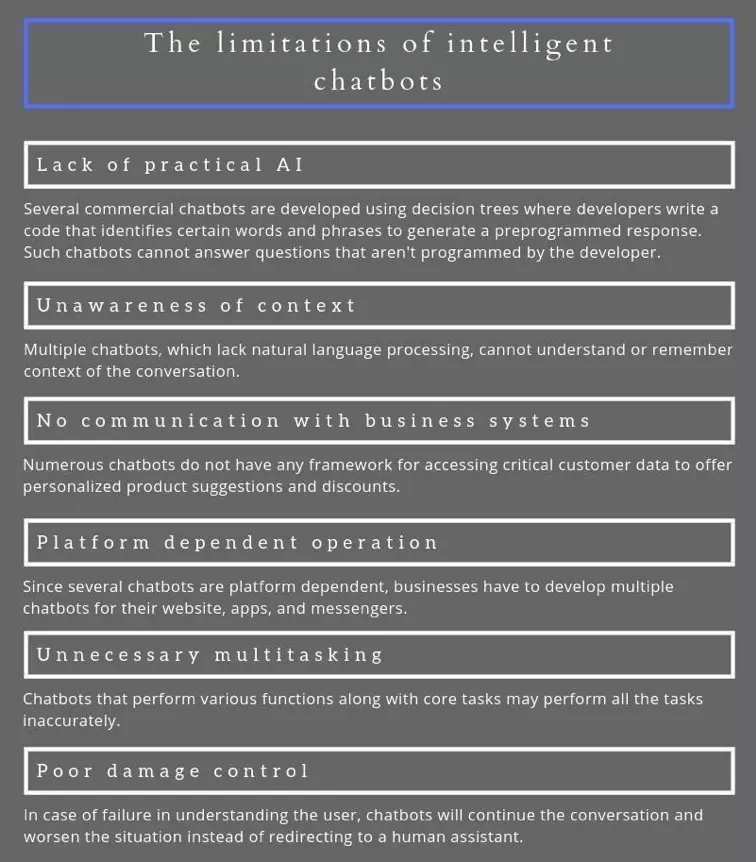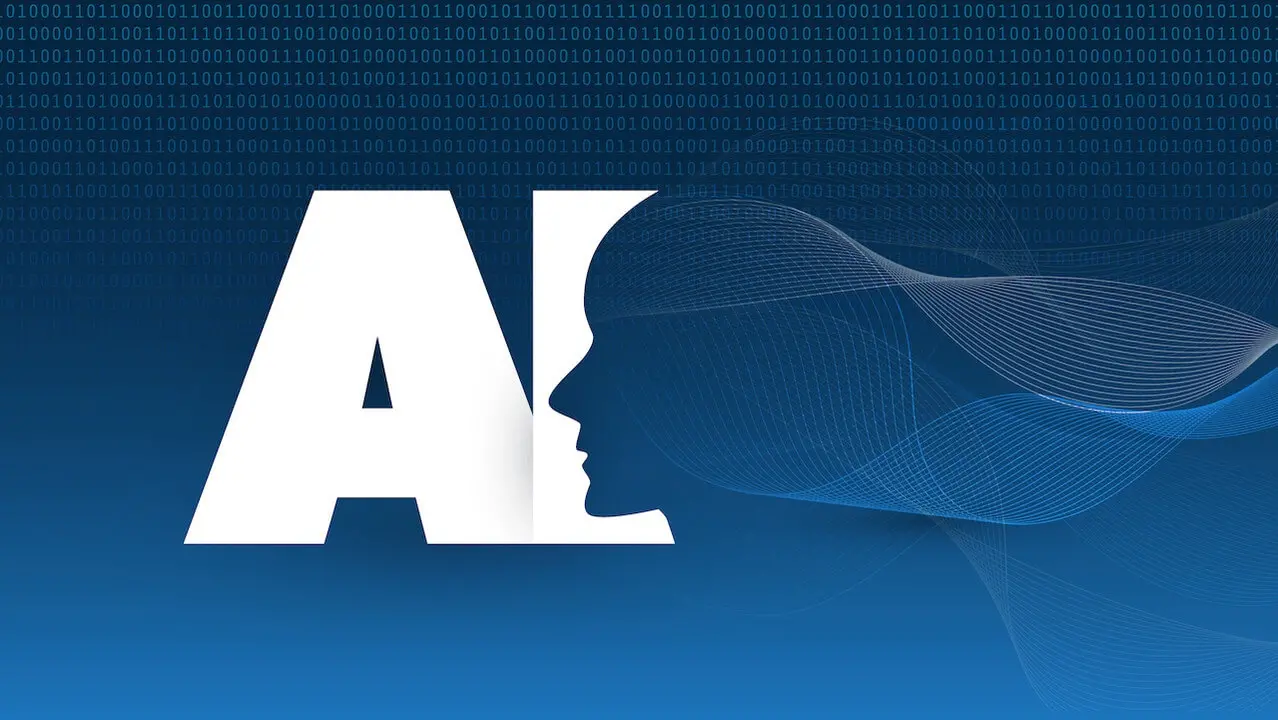Today's chatbots fail to understand human context, display emotions and retain customers.
Intelligent chatbots have taken over essential tasks such as customer service, marketing, and sales in numerous organizations. But are chatbots ready to take up more?
In 1966, ELIZA, the first chatbot, was created in the MIT AI laboratory to simulate human conversations using pre-programmed responses. ELIZA had no framework for understanding context of the conversation and answered queries based solely on user prompts. Years of extensive research and development has led to the rise of intelligent chatbots that can answer queries, perform varying tasks, and execute business operations like customer service and data collection. An interesting example of intelligent chatbot is a real-estate chatbot that automates interaction with potential real-estate leads and assigns real-estate marketers to such leads using social media. But, the popularity of chatbots has also led to an influx of the not-so-intelligent chatbots in several businesses. Such chatbots are still not smart enough to answer even the most basic questions or entertain a simple conversation. Such chatbots lack the backing of the right algorithms that are powered by natural language processing, machine learning, and emotional intelligence.
THE LIMITAIONS OF INTELLIGENT CHATBOTS

1. Lack of practical AI
Several commercial chatbots are developed using decision trees and not AI. The developer writes a code that identifies certain words and phrases to generate a preprogrammed response. Any query that lies outside the preprogrammed interaction will confuse the chatbot and generate an undesirable response. Developers have to plan and create multiple scenarios to program the chatbot. But, some developers miss out or ignore certain scenarios and so the chatbot will be ineffective in its application. Generally, chatbots offering dropdown list of questions are made using decision trees. Such chatbots function as customer service bots. For example, a food delivery service may deploy an intelligent chatbot that has options such as ‘Where is my order?’, ‘I want to cancel my order,’ and ‘I want to provide special instructions’ in its dropdown. Based on the selected option, chatbot provides a relevant response. Now, such chatbots cannot help beyond these questions. These not-so-smart chatbots may also not be prepared to handle sudden change in commands from a customer or to spot the nuances in a command. For example, while using an intelligent chatbot in a café, a user says, ‘I want to order a large cappuccino,’ but then quickly changes his statement to, ‘I meant a regular cappuccino’ . Now the un-intelligent chatbot may end up replying with, ‘Got it! 1 large cappuccino and 1 regular cappuccino.’ A lot of small and medium-sized businesses rely on chatbots that are not entirely developed to handle different types of users and scenarios.
2. Unawareness of Context
Intelligent chatbots were created with the vision of simulating human conversations. intelligent chatbots but fail miserably. One of the major causes for such a failure is that chatbots cannot understand or remember the context of a conversation. These chatbots lack natural language processing, which is crucial for understanding the context in human language. For example, if a user asks about the weather in San Francisco and in the next question asks about nearby restaurants, then the chatbot may ask for their location again.
3. No Communication with Business Systems
Several businesses implement a data-driven marketing approach to ensure a personalized customer experience. Such a personalized approach is preferred by customers and increases revenue and brand loyalty. For data-driven marketing, marketers suggest products and discounts based on customer data and past purchases. But, several intelligent chatbots do not have a framework to access critical customer data. Hence, the discounts and product suggestions offered by the chatbot may or may not cater to customer's requirements, resulting in poor customer experience.
4. Platform Dependent Operation
Currently, most of the intelligent chatbots are platform dependent. Chatbots developed for Facebook will only work on Facebook, chatbots for WeChat only function on WeChat and so on. Therefore, businesses have to develop multiple chatbots for their website, apps, and messengers. Well-established businesses may have the resources and the budget for developing separate intelligent chatbots for multiple platforms. But, small and medium businesses cannot afford this. Such businesses may settle with rudimentary chatbots that only respond to a limited set of queries. Hence, the development of a framework that enables integration with various platforms is a necessity for reducing expenses and providing a streamlined experience across every platform.
5. Unnecessary Multitasking
Often developers create intelligent chatbots that attempt multitasking along with its core tasks. Developing an intelligent chatbot that handles marketing, customer complaints, collects data, and performs various tasks along with giving sassy replies is complex even for a team of experienced developers. Also, chatbots that fail at performing core tasks deeply affect customer experience leading to customers avoiding the chatbot altogether. Hence, a chatbot that effectively carries out one or two significant tasks is always better than a chatbot that tries to do everything at once.
6. Poor Damage Control
Multiple commercial chatbots fail at understanding customer queries. In such scenarios, chatbots tend to make the situation worse by continuously asking the customer to rephrase their question or by giving witty responses to divert the user’s attention. Such an approach annoys the user even more. Hence, chatbots should incorporate a built-in response for such situations and redirect to a human assistant.
AN EFFICIENT APPROACH FOR CREATING SMARTER CHATBOTS

To overcome the shortcomings of chatbots, businesses need to create chatbots with the vision of improving the end-user experience. Such chatbots can be created using the following approach:
1. Predefined Use Cases
Before starting the development of chatbots, developers and business owners should decide whether the chatbot will function in an open domain or a closed domain. An open domain chatbot is harder to develop as it can answer various questions and perform different types of tasks. Siri, Cortana, Google Assistant, and Alexa are some of the most intelligent chatbots in open domain. Whereas, chatbots that do specific tasks such as customer support or data collection for business are part of the closed domain. For example, a Starbucks chatbot on Facebook messenger takes food and beverage orders from customers. Most businesses develop intelligent chatbots in closed domain. Hence, business leaders and programmers need to define use cases for the chatbot and train the bot to perform the core tasks effectively.
2. Deployment of Machine Learning and NLP
Machine learning and natural language processing are essential for developing intelligent chatbots. Machine learning trains chatbots with the help of data analysis to identify patterns and make informed decisions without human intervention. Natural language processing enables analysis and synthesis of a user’s language to understand the context used in a conversation. Hence, with NLP and machine learning, intelligent chatbots can improve their ability to interact with users. Additionally, developers should know that even after training chatbots with machine learning and implementing NLP, chatbots may not be prepared for every situation. There will always be certain user queries that may confuse chatbots. For such scenarios, developers must add a framework to transfer control to a human assistant.
Increasing research and development in AI and machine learning is leading to the generation of advanced chatbots across all domains making the adoption of chatbots less expensive. Some developers are already developing chatbots that can negotiate just like humans. Such applications will have the potential to automate business negotiations in the near future.



Leave your comments
Post comment as a guest